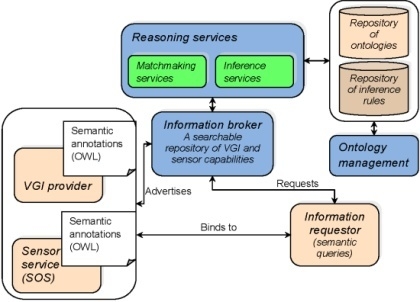Semantic Interoperability of Sensor Data with Volunteered Geographic Information: A Unified Model
Abstract
:1. Introduction
- We start by presenting, analyzing and discussing the different types of VGI, especially in order to identify the type of output that they produce. This will set the foundation for developing the model for the description of VGI.
- We have developed a model of VGI that describes the characteristics of these VGI applications and of the data they produce (we use the term “VGI applications” to refer to any software product where humans can use or produce VGI [8]). This model’s contribution is to support the management of VGI and its integration into semantic interoperability processes, by providing the conceptual basis for the generation of common descriptions of the heterogeneous VGI applications. These descriptions will act as common interfaces, and their contribution will be to enable the querying and correct interpretation of VGI provided through different applications through a single platform.
- We propose an architecture that explains the process of integrating sensor data and VGI within the same platform and which includes semantic annotation and semantic services to enable the semantic reconciliation of data coming from a variety of sources.
2. An Overview of VGI: New Opportunities and Challenges
2.1. The Emergence of the VGI Paradigm
2.2. Opportunities Emerging from VGI
2.3. Challenges Related to VGI
2.4. Geospatial Semantics and VGI
3. VGI Semantic Model
3.1. What Kind of Information Is Provided through VGI Applications?
| Types of VGI | Examples | |
|---|---|---|
| Type | Sub-Types | |
| VGI provided by sensing device | Pictures | Photo sharing websites (e.g., Flickr, Panoramio, 360cities, MySpace) |
| Video | YouTube | |
| Sound record | Bird songs (e.g., xeno-canto) | |
| Data stream | Sensor data provided by volunteers (e.g., through open platforms such as www.geocens.ca or 52North), weather reports (e.g., 360.org) | |
| Geo-referenced text | Text ratings of touristic places (e.g., in MouthShut.com, Foursquare), text description of geo-located phenomena (e.g., WikiCrimes) | |
| Geo-referenced feature | Collaborative mapping projects (e.g., OpenStreetMap, Wikimapia, WayFaring.com, GoogleMapMaker), GPS vehicle traces (trajectories, e.g., Inrix), trajectories of outdoor activities (e.g., Endomondo, Map My Tracks), polygons representing land cover type (e.g., GeoWiki) | |
3.2. Description of the VGI Semantic Model

| Class | Meaning |
|---|---|
| VI_Context Element | A type of attribute that describes context (task, intended purpose, etc.) |
| VI_Contributor User | The ID of a contributor (user) |
| VI_Geometric Feature | subclass of VI_Georeferenced Feature that has a spatial extent |
| VI_Georeferenced Feature | Instantiated by any geo-located features |
| VI_Label | A string used in a Tag as the name of an attribute |
| VI_Label Value | A value for the Label used in a Tag (string or number) |
| VI_Location | The position of a Georeferenced Feature |
| VI_Mobile Feature | A georeferenced feature which position changes over time |
| VI_Mobile Sensing Device | A Sensor Device which position changes over time |
| VI_Profile Element | Attributes describing the profile of the Contributor User |
| VI_Quality Element | An attribute describing the quality of an instance of VGI Type (e.g., accuracy) |
| VI_Sensing Device | A device that records observations of a specific attribute |
| VI_Sensing Device Output | The observation generated by a Sensing Device |
| VI_Static Sensing Device | A Sensor Device which position does not change over time |
| VI_Tag | A combination of Label and LabelValue for describing a Georeferenced Feature |
| VI_Trajectory | The path followed by the Moving Feature in space |
| VI_VGI Application | The name of the source (e.g., OSM) |
| VI_VGI Context | Composed of a set of context elements |
| VI_VGI Type | A root class that encompasses all categories of VGI |
4. Toward a Unified Framework for Semantic Interoperability of Sensor Data with VGI
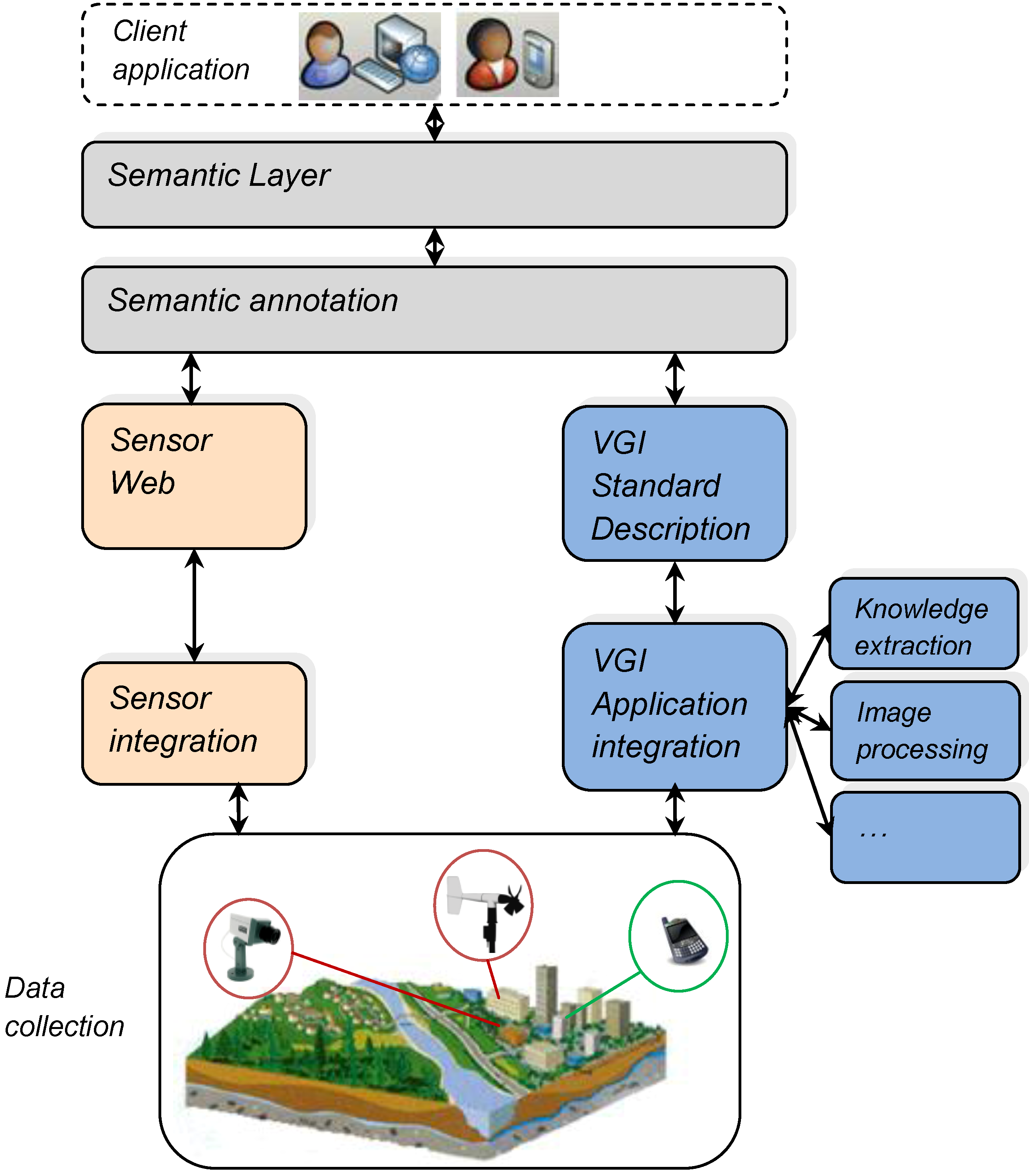
4.1. Integrating Sensors with the Sensor Web
4.2. VGI Application Integration
4.2.1. Registration of VGI Applications
- URL of the VGI application, which will constitute the application’s unique identifier (attribute of the VI_VGI Application class)
- Contact information of the company or the person that operates the VGI application (attribute of the VI_VGI Application class)
- Context elements on the VGI application (instances of the VI_Context Element class), including keywords describing:
- ○
- the intended use(s) of the VGI being provided
- ○
- the application domain
- ○
- the geographical area being covered, and
- ○
- the date when the application was created
- Type of VGI being collected (i.e., sensor device output, geo-referenced features, and/or text)
4.2.2. Grounding VGI into the VGI Semantic Model
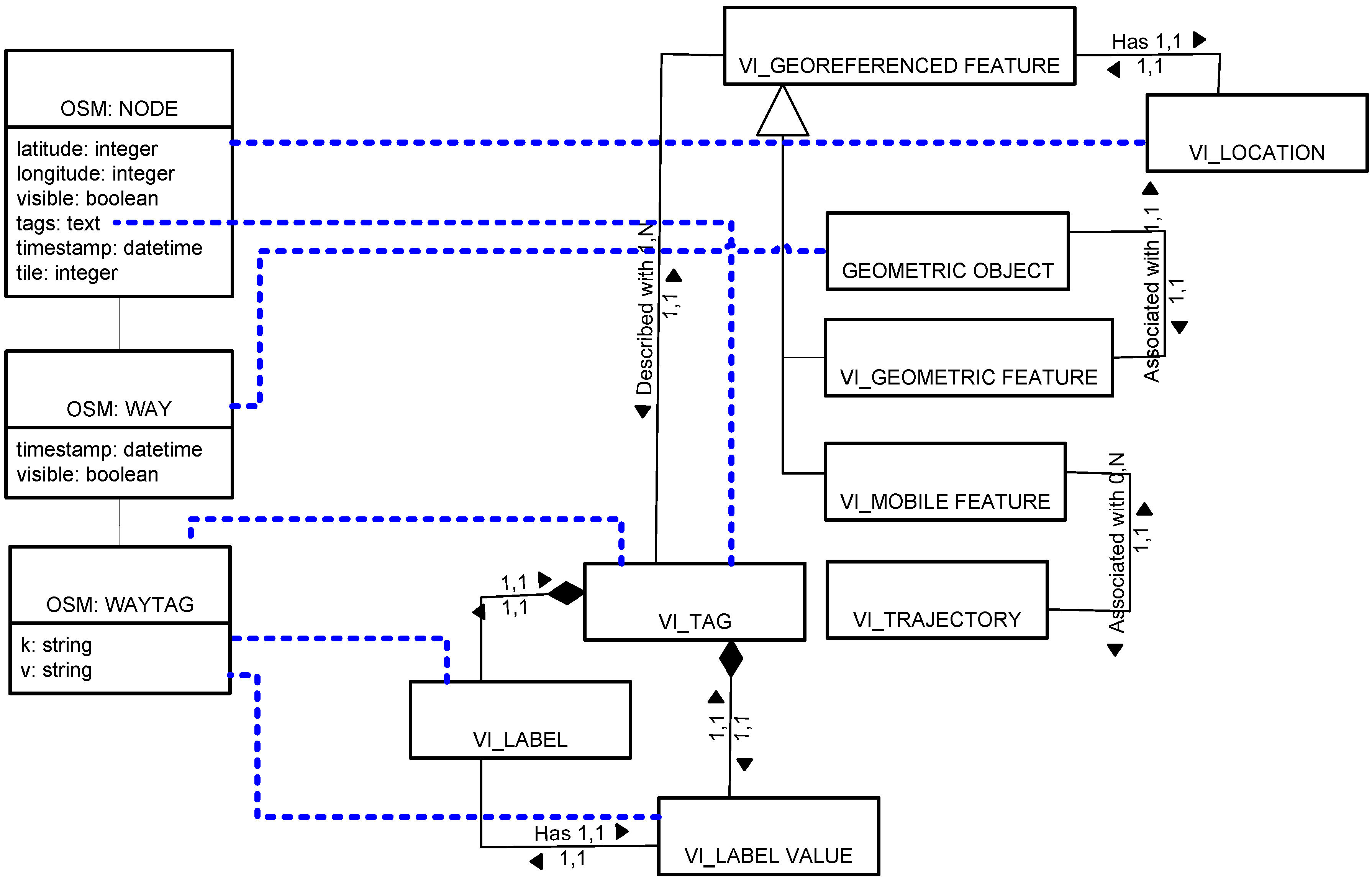

4.3. Semantic Annotation
- Semantic markup: this expression is employed when the semantic annotations are included within the information source;
- Registration: this expression is used when the semantic annotation is stored within the ontology;
- Registration mapping: this expression is employed when semantic annotations are stored in a separate source, which contains pairs of identifiers from the information source and the reference ontology.
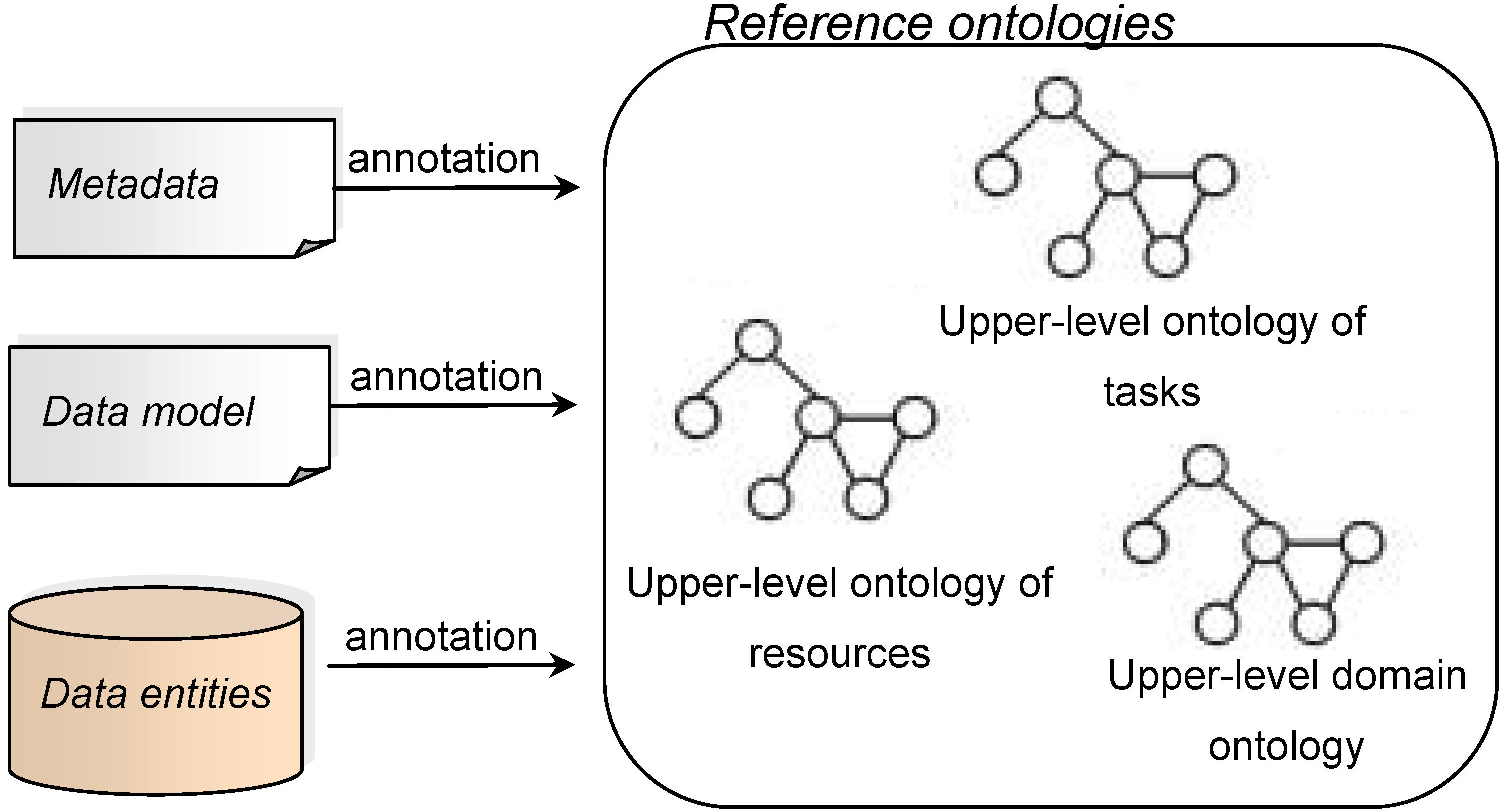
4.4. Semantic Layer
- Context elements, such as the intended use(s) of the data, the application domain, the geographical area being covered, etc.
- Type of data (i.e., videos, pictures, geometries, etc.)
- The quality of data
- The entities (objects of events) of interest
- The properties of entities of interest
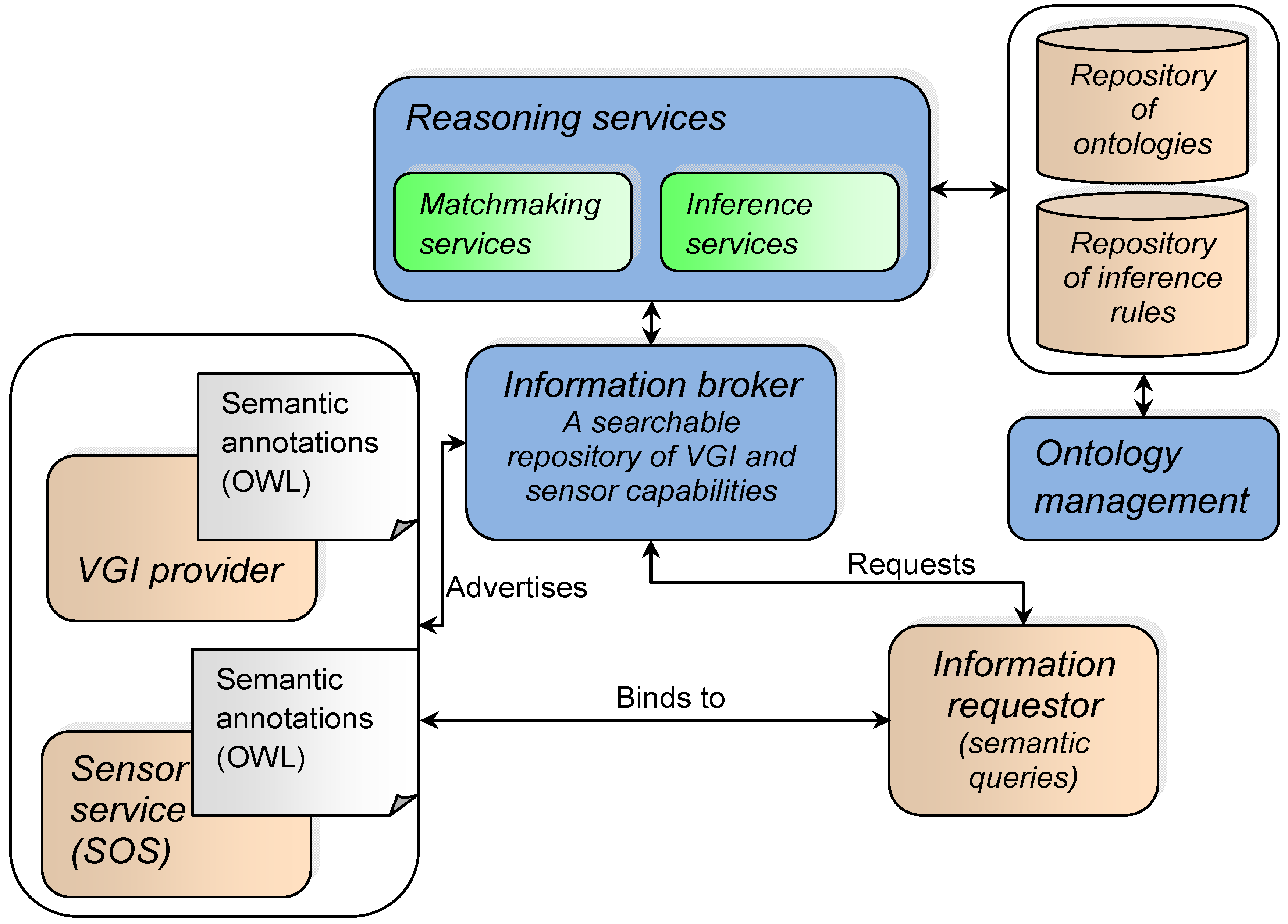
5. Application of the Framework
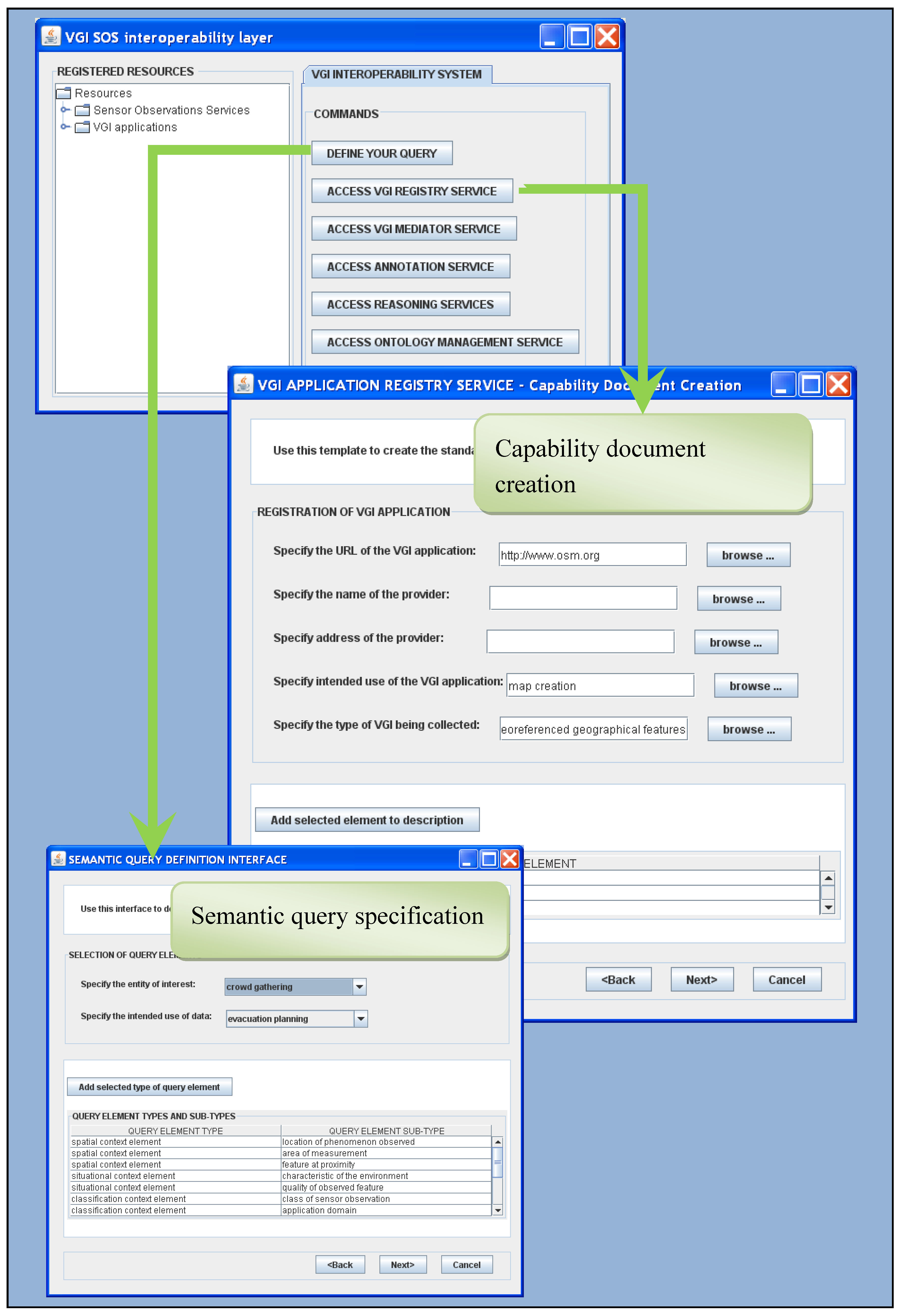




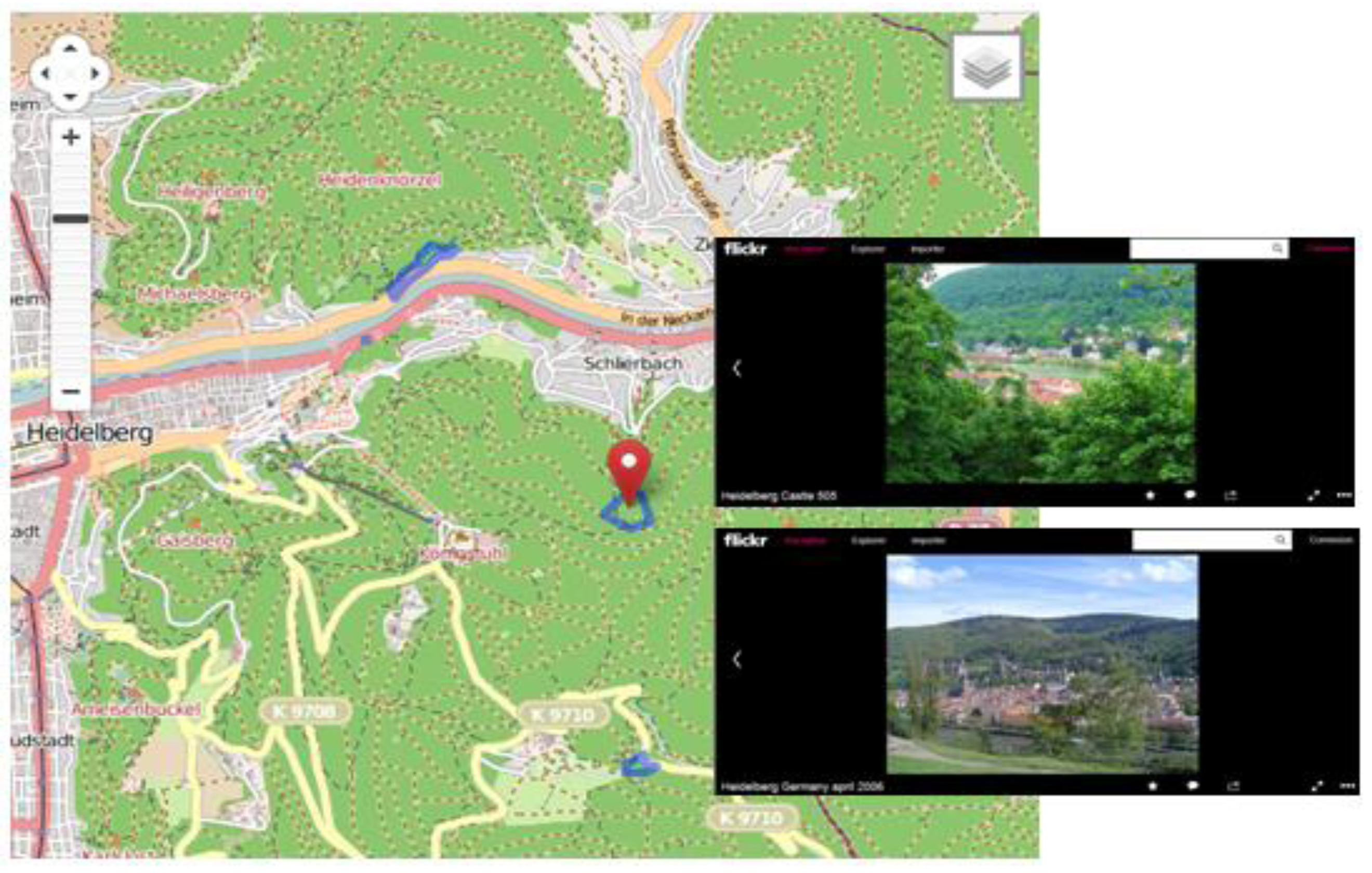
| Services | Functionalities of services |
|---|---|
| VGI application registry service | Create capability description: enables the provider to describe the profile of the VGI application according to template profile |
| Advertise capabilities: the VGI application registry service notifies the information broker of the capabilities of available VGI applications | |
| VGI Semantic Model mediator service | Upload local model: uploads the data model of a VGI application into the VGI Semantic Model mediator |
| Create mapping: creates a new mapping between an element of the loaded VGI data model and an element of the VGI Semantic Model | |
| Lookup description: returns the description of an element of the VGI Semantic Model | |
| Semantic annotation service | Upload local terminology: uploads the terminology (XML) used by the VGI application |
| Upload reference ontology: uploads a selected reference ontology from the registry of reference ontologies | |
| Lookup description: returns the description of an element of the loaded reference ontology | |
| Create registration mapping: creates a new registration mapping between an element of the loaded terminology and an element of the loaded reference ontology | |
| Call automated semantic annotation tool: calls a selected automated semantic annotation tool | |
| Import output of automated semantic annotation tool: imports the output relation(s) of an automated semantic annotation tool and inserts the retrieved relation(s) into a registration mapping | |
| Call knowledge extraction tool: call selected extraction tool | |
| Import output of knowledge extraction tool: imports the output term(s) of a knowledge extraction tool and inserts the retrieved term(s) into the capability description document | |
| Reasoning services | Upload reference ontology: uploads a selected reference ontology from the registry of reference ontologies into the reasoning service |
| Select matchmaker: selects the matchmaker algorithms for a matching task | |
| Call matchmaker: sends a semantic query and a list of capability description documents to the selected matchmaker | |
| Call inference engine: sends a set of facts to the inference engine to retrieve new facts | |
| Ontology management services | Upload reference ontology: uploads a selected reference ontology from the registry of reference ontologies into the ontology editor |
| Create ontology: creates a new ontology to be added to the registry of reference ontologies | |
| Update reference ontology: updates the loaded reference ontology |
6. Conclusion and Remaining Challenges
Acknowledgements
Conflict of Interest
References and Notes
- Goodchild, M.F. Citizens as sensors: The world of volunteered geography. GeoJournal 2007, 69, 211–221. [Google Scholar] [CrossRef]
- Elwood, S. Volunteered geographic information: Future research directions motivated by critical, participatory, and feminist GIS. GeoJournal 2008, 72, 173–183. [Google Scholar]
- Song, W.; Sun, G. The Role of Mobile Volunteered Geographic Information in Urban Management. In Proceedings of the 18th International Conference on Geoinformatics, Beijing, China, 18–20 June 2010; pp. 1–5.
- Grossner, K.; Glennon, A. Volunteered Geographic Information: Level III of a Digital Earth System. Proceedings of the Position paper presented at the Workshop on Volunteered Geographic Information, Santa Barbara, CA, USA, 13–14 December 2007; p. 2. Available online: http://www.ncgia.ucsb.edu/projects/vgi/docs/position/Grossner_Glennon_paper.pdf (accessed on 22 March 2012).
- Tulloch, D. Is volunteered geographic information participation? From vernal pools to videogames. GeoJournal 2008, 72, 161–171. [Google Scholar] [CrossRef]
- Goetz, M.; Zipf, A. Towards Defining a Framework for the Automatic Derivation of 3D CityGML Models from Volunteered Geographic Information. In Proceedings of the Joint ISPRS Workshop on 3D City Modelling & Applications and the 6th 3D GeoInfo Conference, Wuhan, China, 26–28 June 2011; pp. 1–16.
- De Longueville, B.; Annoni, A.; Schade, S.; Ostlaender, N.; Withmore, C. Digital Earth’s nervous system for crisis events: Real-time sensor web enablement of volunteered geographic information. Int. J. Digital Earth 2010, 3, 242–259. [Google Scholar] [CrossRef]
- Ostlaender, N.; Smith, R.S.; de Longueville, B.; Smits, P. What VGI is Good For-designing a Methodology for Comparative Analysis of Existing Applications to Classify VGI and its Use. In Proceedings of the IGARSS, Honolulu, HI, USA, 25–30 July 2010; pp. 1422–1425.
- Ballatore, A.; Bertolotto, M. Semantically Enriching VGI in Support of Implicit Feedback Analysis. In Proceedings of the 10th Web and Wireless Geographical Information Systems Conference (W2GIS 2011), Kyoto, Japan, 3–4 March 2011; Tanaka, K., Fröhlich, P., Kim, K.-S., Eds.; LNCS 6574. Springer-Verlag: Berlin/Heidelberg, Germany, 2011; pp. 78–93. [Google Scholar]
- Goodchild, M.F. Towards a geography of geographic information in a digital world. Comput. Environ. Urban Syst. 1997, 21, 377–391. [Google Scholar] [CrossRef]
- Hardy, D. Volunteered Geographic Information in Wikipedia. Ph.D. Thesis, University of California, Santa Barbara, CA, USA, 2010; p. 260. [Google Scholar]
- Coleman, D.; Georgiadou, Y.; Labonté, J. Volunteered geographic information: The nature and motivation of produsers. Int. J. Spatial Data Infrastruct. Res. 2009, 4, 332–358. [Google Scholar]
- Goetz, M.; Lauer, J.; Auer, M. An Algorithm-based Methodology for the Creation of a Regularly Updated Global Online Map Derived from Volunteered Geographic Information. In Proceedings of the Fourth International Conference on Advanced Geographic Information Systems, Applications, and Services, Valencia, Spain, 30 January–4 February 2012; pp. 50–58.
- Gupta, R. Mapping the Global Energy System Using Wikis, Open Sources, WWW, and Google Earth. Proceedings of the Position paper presented at the Workshop on Volunteered Geographic Information, Santa Barbara, CA, USA, 13–14 December 2007; p. 2. Available online: http://www.ncgia.ucsb.edu/projects/vgi/docs/position/Gupta_paper.pdf (accessed on 22 March 2012).
- Palen, L.; Vieweg, S.; Liu, S.B.; Hughes, A.L. Crisis in a networked world: Features of computer-mediated communication in the April 16, 2007, Virginia Tech event. Soc. Sci. Comput. Rev. 2009, 27, 467–480. [Google Scholar] [CrossRef]
- De Rubeis, V.; Sbarra, P.; Tosi, P. Web-based Macro-seismic Survey: Fast Information Exchange and Elaboration of Seismic Intensity Effects in Italy. Proceedings of the 6th International ISCRAM Conference, Gothenburg, Sweden, 10–13 May 2009; p. 11. Available online: http://www.iscram.org/ISCRAM2009/papers/ (accessed on 22 March 2012).
- Mooney, P.; Corcoran, P. Annotating Spatial Features in OpenStreetMap. In Proceedings of the GISRUK 2011, Portsmouth, UK, 27–29 April 2011; pp. 52–56.
- Budhathoki, N.; Bruce, B.; Nedovic-Budic, Z. Reconceptualizing the role of the user of spatial data infrastructure. GeoJournal 2008, 72, 149–160. [Google Scholar] [CrossRef]
- Sieber, R. Geoweb for Social Change. Proceedings of the Position Paper Presented at the Workshop on Volunteered Geographic Information, Santa Barbara, CA, USA, 13–14 December 2007; p. 3. Available online: http://www.ncgia.ucsb.edu/projects/vgi/docs/supp_docs/ Sieber_paper.pdf (accessed on 22 March 2012).
- Bishr, M.; Mantelas, L. A trust and reputation model for filtering and classifying knowledge about urban growth. GeoJournal 2008, 72, 229–237. [Google Scholar] [CrossRef]
- Flanagin, A.; Metzger, M. The credibility of volunteered geographic information. GeoJournal 2008, 72, 137–148. [Google Scholar] [CrossRef]
- Gouveia, C.; Fonseca, A. New approaches to environmental monitoring: The use of ICT to explore volunteer geographic information. GeoJournal 2008, 72, 185–197. [Google Scholar] [CrossRef]
- Scheider, S.; Keßler, C.; Ortmann, J.; Devaraju, A.; Trame, J.; Kauppinen, T.; Kuhn, W. Semantic Referencing of Geosensor Data and Volunteered Geographic Information. In Geospatial Semantics and the Semantic Web. Semantic Web and Beyond; Springer: New York, NY, USA, 2011; pp. 27–59. [Google Scholar]
- Hyon, J. Position Paper on “Specialist Meeting on Volunteered Geographic Information.”. In Proceedings of the Position paper presented at the Workshop on Volunteered Geographic Information, Santa Barbara, CA, USA, 13–14 December 2007; p. 2.
- Kuhn, W. Geospatial semantics: Why, of what and how? J. Data Semant. III 2005, 3534, 1–24. [Google Scholar] [CrossRef]
- Brodaric, B.; Gahegan, M. Ontology use for semantic e-science. Semant. Web 2010, 1, 149–153. [Google Scholar]
- Cohn, A.G.; Hazarika, S.M. Qualitative spatial representation and reasoning: An overview. Fundam. Informaticae 2001, 46, 1–29. [Google Scholar]
- Kuhn, W. Cognitive and Linguistic Ideas in Geographic Information Semantics. In Cognitive and Linguistic Aspects of Geographic Space, Lecture Notes in Geoinformation and Cartography; Raubal, M., Mark, D.M., Frank, A.U., Eds.; Springer: Berlin/Heidelberg, Germany, 2013; pp. 159–174. [Google Scholar]
- Janowicz, K.; Scheider, S.; Pehle, T.; Hart, G. Geospatial semantics and linked spatiotemporal data-past, present, and future. Semant. Web 2012, 3, 1–13. [Google Scholar]
- Kuhn, W.; Raubal, M. Implementing Semantic Reference Systems. In Proceedings of the AGILE 2003—6th AGILE Conference on Geographic Information Science, Lyon, France, 24–26 April 2003; pp. 63–72.
- Kuhn, W. Semantic reference systems. Int. J. Geogr. Inf. Sci. 2003, 17, 405–409. [Google Scholar] [CrossRef]
- Parundekar, R.; Knoblock, C.A.; Ambite, J.L. Aligning Ontologies of Geospatial Linked Data. In Proceedings of the Workshop On Linked Spatiotemporal Data, in Conjunction with the 6th International Conference on Geographic Information Science (GIScience 2010), Zurich, Switzerland, 14 September 2010.
- Auer, S.; Lehmann, J.; Hellmann, S. LinkedGeoData-adding a Spatial Dimension to the Web of Data. In Proceedings of the 8th International Semantic Web Conference (ISWC), Chantilly, VA, USA, 25–29 October 2009; Bernstein, A., Karger, D.R., Heath, T., Feigenbaum, L., Maynard, D., Motta, E., Thirunarayan, K., Eds.; Springer Verlag: Berlin/Heidelberg, Germany, 2009. LNCS 5823. pp. 731–746. [Google Scholar]
- De Groeve, T.; Stollberg, B.; Vernaccini, L.; Dohorty, B. Mash-up or SDI: Appropriate Mapping Tools for Emergency Situation Rooms. In Proceedings of the 2000 Geomatics for Disaster Management Conference, Torino, Italy, 2–4 February 2010; pp. 122–130.
- Manso, M.-A.; Wachowicz, M. GIS design: A review of current issues in interoperability. Geogr. Compass 2009, 3, 1105–1124. [Google Scholar] [CrossRef]
- Turnitsa, C.; Tolk, A. Battle Management Language: A Triangle with Five Sides. In Proceedings of the Simulation Interoperability Standards Organization (SISO) Spring Simulation Interoperability Workshop (SIW), Huntsville, AL, USA, 2–7 April 2006.
- De Longueville, B.; Smith, R.S.; Luraschi, G. OMG, from here, I can see the Flames!: A Use Case of Mining Location based Social Networks to Acquire Spatio-temporal Data on Forest Fires. In Proceedings of the 2009 International Workshop on Location-based Social Networks, Seattle, WA, 4–6 November 2009; Zhou, X., Xie, X., Eds.; ACM: New York, USA, 2009; pp. 73–80. [Google Scholar]
- Lüscher, P.; Weibel, R. Exploiting empirical knowledge for automatic delineation of city centres from large-scale topographic databases. Comput. Environ. Urban Syst. 2012, 37, 18–34. [Google Scholar] [CrossRef]
- Hile, H.; Vedantham, R.; Cuellar, G.; Liu, A.; Gelfand, N.; Grzeszczuk, R.; Borriello, G. Landmark-based Pedestrian Navigation from Collections of Geotagged Photos. In Proceedings of the 7th International Conference on Mobile and Ubiquitous Multimedia, Umeå, Sweden, 3–5 December 2008; pp. 145–152.
- Kisilevich, S.; Krstajić, M.; Keim, D.; Andrienko, N.; Andrienko, G. Event-based Analysis of People’s Activities and Behavior using Flickr and Panoramio Geotagged Photo Collections. In Proceedings of 14th International Conference on Information Visualization, London, UK, 26–29 July 2010; pp. 289–296.
- Birkin, M.; Malleson, N.; Hudson-Smith, A.; Gray, S.; Milton, R. Calibration of a spatial simulation model with volunteered geographical information. Int. J. Geogr. Inf. Sci. 2011, 25, 1221–1239. [Google Scholar] [CrossRef]
- Furtado, V.; Ayres, L.; de Oliveira, M.; Vasconcelos, E.; Caminha, C.; D’Orleans, J.; Belchior, M. Collective intelligence in law enforcement—The WikiCrimes system. Inf. Sci. 2010, 180, 4–17. [Google Scholar] [CrossRef]
- Lemmens, R. Semantic Interoperability of Distributed Geo-services. Ph.D. Thesis, International Institute for Geo-Information Science and Earth Observation (ITC), Enschede, The Netherlands, 2006; p. 323. [Google Scholar]
- Grenon, P.; Smith, B. SNAP and SPAN: Towards dynamic spatial ontology. J. Spatial Cognit. Comput. 2004, 4, 69–104. [Google Scholar] [CrossRef]
- Bröring, A.; Echterhoff, J.; Jirka, S.; Simonis, I.; Everding, T.; Stasch, C.; Liang, S.; Lemmens, R. New generation sensor web enablement. Sensors 2011, 11, 2652–2699. [Google Scholar] [CrossRef]
- Botts, M.; Percivall, G.; Reed, C.; Davidson, J. OGC Sensor Web Enablement: Overview and High Level Architecture. In Proceedings of the GeoSensor Networks (GSN 2006), LNCS 4540. Boston, USA, 1-3 October 2006; Nittel, S., Labrinidis, A., Stefanidis, A., Eds.; Springer-Verlag: Berlin/Heidelberg, Germany; pp. 175–190.
- Open Geospatial Consortium (OGC), OGC Sensor Event Service Interface Specification-Version 0.3.0; Open Geospatial Consortium: Wayland, MA, USA, 2008.
- Walter, K.; Nash, E. Coupling Wireless Sensor Networks and the Sensor Observation Service—Bridging the Interoperability Gap. In Proceedings of the 12th AGILE International Conference on Geographic Information Science 2009, Hannover, Germany, 2–5 June 2009; pp. 1–9.
- Gigan, G.; Atkinson, I. Sensor Abstraction Layer: A Unique Software Interface to Effectively Manage Sensor Networks. In Proceedings of the 3rd International Conference on Intelligent SensorsSensor Networks and Information (ISSNIP 2007), Melbourne, QLD, Australia, 3–6 December 2007; pp. 479–484.
- Bakillah, M.; Mostafavi, M.A. G-map Semantic Mapping Approach to Improve Semantic Interoperability of Distributed Geospatial Web Services. In Proceedings of the Advances in Conceptual Modeling–Applications and Challenges (ER 2010 Workshops), Vancouver, BC, Canada, 1–4 November 2010; Trujillo, J., Dobbie, G., Kangassalo, H., Hartmann, S., Kirchberg, M., Rossi, M., Reinhartz-Berger, I., Zimányi, E., Frasincar, F., Eds.; Springer-Verlag: Berlin/Heidelberg, Germany, 2010. LNCS 6413. pp. 12–22. [Google Scholar]
- Janowicz, K.; Keßler, C.; Schwarz, M.; Wilkes, M.; Panov, I.; Espeter, M.; Baeumer, B. Algorithm, Implementation and Application of the SIM-DL Similarity Server. In Proceedings of the Second International Conference on GeoSpatial Semantics (GeoS 2007), Mexico City, Mexico, 29–30 November 2007; pp. 128–145.
- Bakillah, M.; Liang, S.H.L. Discovering Sensor Services with Social Network Analysis and Expanded Sqwrl Querying. In Proceedings of the 11th Web and Wireless Geographical Information Systems Conference (W2GIS 2012), Naples, Italy, 12–13 April 2012; di Martino, S., Peron, A., Tezuka, T., Eds.; Springer-Verlag: Berlin/Heidelberg, Germany, 2012. Lecture Notes in Computer Sciences. [Google Scholar]
- Bittner, T.; Donnelly, M.; Winter, S. Ontology and Semantic Interoperability. In Large Scale 3D Data Integration: Challenges and Opportunities; Zlatanova, S., Prosperi, D., Eds.; CRC Taylor and Francis: Boca Raton, FL, USA, 2005; pp. 139–160. [Google Scholar]
- Klien, E. A rule-based strategy for the semantic annotation of geodata. Trans. GIS 2007, 11, 437–452. [Google Scholar] [CrossRef]
- Janowicz, K.; Schade, S.; Bröring, A.; Keßler, C.; Maué, P.; Stasch, C. Semantic Enablement for Spatial Data Infrastructures. Trans. GIS 2010, 14, 111–129. [Google Scholar] [CrossRef]
- Maué, P.; Schade, S.; Duchesne, P. OGC Discussion Paper 08-167r1: Semantic Annotation in OGC Standards; Technical Report; OGC: Wayland, MA, USA, 2009. [Google Scholar]
- Schwering, A. Approaches to semantic similarity measurement for geo-spatial data: A survey. Trans. GIS 2008, 12, 5–29. [Google Scholar] [CrossRef]
- Ballatore, A.; Bertolotto, M.; Wilson, D.C. Geographic knowledge extraction and semantic similarity in OpenStreetMap. Knowl. Inf. Syst. 2012, 2012, 1–21. [Google Scholar]
- Mülligann, C.; Janowicz, K.; Ye, M.; Lee, W.C. Analyzing the Spatial-semantic Interaction of Points of Interest in Volunteered Geographic Information. In Spatial Information Theory; Egenhofer, M., Giudice, N., Moratz, R., Worboys, M., Eds.; Springer: Berlin/Heidelberg, Germany, 2011; COSIT 2011, LNCS 6899; pp. 350–370. [Google Scholar]
- Bakillah, M.; Mostafavi, M.A.; Brodeur, J.; Bédard, Y. Sim-Net: A view-based semantic similarity model for ad hoc network of geospatial databases. Trans. GIS 2009, 13, 417–447. [Google Scholar] [CrossRef]
- Papamarkos, G.; Poulovassilis, A.; Wood, P.T. Event-Condition-Action Rule Languages for the Semantic Web. In Proceedings of the Workshop on Semantic Web and Databases (SWDB 03), Berlin, Germany, 7–8 September 2003; pp. 309–327.
- Wiegand, N.; Garcia, C. A task-based ontology approach to automate geospatial data retrieval. Trans. GIS 2007, 11, 355–376. [Google Scholar] [CrossRef]
- Bakillah, M.; Liang, S.H.L. A dynamic and context-aware semantic mediation service for discovering and fusion of heterogeneous sensor data. J. Spatial Inf. Sci. 2013, 6, 155–185. [Google Scholar]
- Cardoso, J. The Semantic Web vision: Where are we? IEEE Intell. Syst. 2007, 22, 84–88. [Google Scholar] [CrossRef]
© 2013 by the authors; licensee MDPI, Basel, Switzerland. This article is an open access article distributed under the terms and conditions of the Creative Commons Attribution license (http://creativecommons.org/licenses/by/3.0/).
Share and Cite
Bakillah, M.; Liang, S.H.L.; Zipf, A.; Arsanjani, J.J. Semantic Interoperability of Sensor Data with Volunteered Geographic Information: A Unified Model. ISPRS Int. J. Geo-Inf. 2013, 2, 766-796. https://doi.org/10.3390/ijgi2030766
Bakillah M, Liang SHL, Zipf A, Arsanjani JJ. Semantic Interoperability of Sensor Data with Volunteered Geographic Information: A Unified Model. ISPRS International Journal of Geo-Information. 2013; 2(3):766-796. https://doi.org/10.3390/ijgi2030766
Chicago/Turabian StyleBakillah, Mohamed, Steve H.L. Liang, Alexander Zipf, and Jamal Jokar Arsanjani. 2013. "Semantic Interoperability of Sensor Data with Volunteered Geographic Information: A Unified Model" ISPRS International Journal of Geo-Information 2, no. 3: 766-796. https://doi.org/10.3390/ijgi2030766
APA StyleBakillah, M., Liang, S. H. L., Zipf, A., & Arsanjani, J. J. (2013). Semantic Interoperability of Sensor Data with Volunteered Geographic Information: A Unified Model. ISPRS International Journal of Geo-Information, 2(3), 766-796. https://doi.org/10.3390/ijgi2030766




